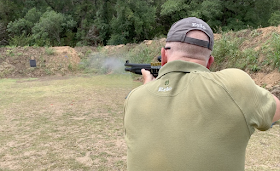The claim of self-defense as a justification is for an intentional act, not for an accident or negligence. Demonstrating competence with your firearm can short-circuit the prosecutor’s potential tactic of arguing that you discharging the firearm was an accident or negligent act rather than intentional self-defense.
What course should you use? There are several approaches you can take in choosing which course of fire to use to demonstrate competency. For the shotgun, I recommend the Department of Energy (these are the guys that guard nuclear weapons and facilities) Shotgun Qualification course or your state or local police qualification course. The Texas Commission on Law Enforcement (TCOLE) Shotgun Instructor Qualification I discuss below is what police firearms instructors must pass to receive TCOLE firearms instructor certification in Texas.
The Texas Commission on Law Enforcement (TCOLE) Shotgun Instructor Qualification course of fire is actually fairly straight forward and requires ten rounds of buckshot or five slugs and five buckshot. Given the scarcity of premium buckshot at this time, I used the cheaper Fiocchi 9 pellet buckshot.
The TCOLE qualification is fired on the standard TQ19 target with all pellets counted as one point. The shooter must score 90% to pass at the instructor level.
The Stages:
25 yards: on command chamber and fire 3 rounds
25 yards: on command chamber and fire 2 rounds
15 yards: on command chamber and fire 3 rounds
10 yards: on command chamber and fire 2 rounds
Click on the picture below for a video of the qualification:
 |
| Texas TCOLE Shotgun Qualification |
I fired the qualification twice, once using a target much smaller than the TQ-19 and once using a B27 target that is closer in size to the TQ19.
My Beretta 1301 is not a 25-yard gun with the Fiocchi buckshot and will have flyers as shown on the cardboard target. Although the wads likely took out evidence of a few hits, I could only account for 78 pellets which was not a passing score. The B27 target contained all 90 pellets which was a 90 or perfect score.
If you enjoy reading these please subscribe. The link is on the upper right side of the page. All that will happen is that you will receive an e-mail when I post an article. Your information will never be distributed.
